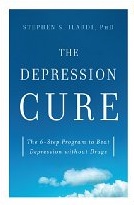In discussion of Stephen Ilardi’s book, “The Depression Cure,” I wanted to offer my my 12 steps to beat depression, as well.
Many comments on the boards lately have asked this question: What did I do to get better, or what would I suggest a person do to get better?
Well, I’m not sure. I spent much of my deep depression wandering aimlessly, completely lost, not knowing which voices to follow. I acted on everyone’s suggestions. Some worked. Others didn’t.
I compiled the exercises that made me feel better into a personally designed 12-step mental health program, related to but different from the 12-step program practiced by addicts and their kin. They are ways to boost my neurotransmitters into action–getting those lazy bones passing messages from one neuron to the next–and to inspire nerve generation and cell reproduction in the amydgala and hippocampus regions of the brain.
Step One: Find the Right Doctor
Some depressives are lucky enough to find a good psychiatrist in their first visit to a head doctor. I wasn’t one of them. I went through six–and practically gave up on all traditional medicine–before I met the seventh, who was perfect for me: she was conservative with meds (she didn’t try a new antipsychotic every week like doctor number two); well-informed on new developments of treatment; and, using her sharp intuition, treated me as a person (with unique personality traits and philosophies that had to be considered), not as a set of symptoms.
Step Two: Find the Right Cocktail
I wish I could report that my doctor waved her wand once to arrive at the magical prescription that cured me. No, a few different faces (six of them) had to wave the wand 23 times before I felt any magic, or found the right cocktail. But that’s extreme. Most depressives have only had to try a few different medications before feeling huge relief.
Step Three: Exercise!
As a recovering addict, I love any buzz I can get. Working out–any exercise that gets my heart rate over 160 beats per minute (into the cardiovascular zone) does the job. And in a safe way, so I don’t have to cheat on my sobriety. I’m probably as addicted to exercise as I was to booze, but this is one mood-altering activity that doesn’t deteriorate my marriage and my other relationships (with my kids, with myself, and with God).
Some researchers say that exercise acts like antidepressants in increasing the activity of serotonin and/or norepinephrine in your brain; working out releases endorphins and other hormones that reduce pain, induce euphoria, have a calming effect, and combat stress.
Step Four: Eat Well
The more I investigate–both through research and nonscientific experiments with body–the more I realize how my diet affects my mood.
Here are the bad boys: nicotine (although I was only a social smoker, I had to give it up because smoking destroys practically every organ inside your body); caffeine (it’s a drug, which is why I’m addicted to it), alcohol (it made me crazy); white flour and processed food (what you live on when you have preschoolers who won’t touch tofu and spinach); and sugar (oh man, I’m trying, but oh man).
Here are the good guys: protein (eggs, milk, cheese, yogurt, meat, fish, chicken, seeds, nuts); complex starches (whole grains, beans, potatoes); vegetables (broccoli, spinach, squash); vitamins (vitamin B-complex, vitamins E and C, and a multivitamin); minerals (magnesium, calcium, and zinc); omega-3 fatty acids.
Step Five: Sleep!
When you give birth to two insomniacs, you have to work extra hard at getting well, because regular sleep is crucial to an effective treatment of depression, and a must for maintaining a stable mood. For a year and a half I’ve kept a mood/sleep journal to track how my zzzzs affects my thoughts. This is what I learned: if I slept less than seven hours, I was prone to mania, and if I slept over nine, I felt more depressed. Alterations in sleep affect circadian rhythms, our internal biological clocks, which govern fluctuations in body temperature and the secretion of several hormones.
Step Six: Light Up
Changes in the amounts of daylight a person gets also alters circadian rhythms, which is why light treatment is so effective, especially for those who suffer from SAD (seasonal affective disorder). If I can’t get outside for at least a half hour a day, I try to sit under my mammoth HappyLite, a lamp with 10,000 lux.
Step Seven: Support and Friendships
I used to be a loyal support-group kind of girl. But since I’ve had kids, getting to meetings is much more difficult. So I’ve found my support in other ways–in phone calls and e-mails and visits to friends and relatives who also suffer from depression or bipolar disorder. That lifeline kept me alive during my suicidal days, and continues to empower me every single day.
During the darker days of my depression last year, I walked around with six phone numbers in my pocket. So to not wear out any one friend or relative, I’d call two people a day, and rotate the numbers. I spent hours on the phone and writing e-mails and visiting friends because I needed constant support.
Step Eight: Get Involved
Positive psychologists like University of Pennsylvania’s Martin Seligman and Dan Baker, Ph.D., director of the Life Enhancement Program at Canyon Ranch, believe a sense of purpose–committing oneself to a noble mission–and acts of altruism are strong antidotes to depression. With two small children to feed and bath, I can only save the world at one very small step at a time. However, my ministry of the day–educating people on mental health–fulfills me in a way that combats some of the blues. Moreover, finding a way to creatively express myself–another piece of the happiness puzzle–has saved me from a meltdown on more than one occasion.
Step Nine: A Gratitude Journal
Based on her research findings, University of California psychologist Sonja Lyubomirsky believes that keeping a gratitude journal–taking the time to consciously count your blessings–is one of the most effective happiness boosters. According to psychologist Robert Emmons at the University of California at Davis, gratitude exercises improves physical health, as well–including raising energy levels and relieving pain.
Step Ten: Cognitive-Behavioral Therapy and Personal Therapy
In addition to seeing a shrink for personal therapy, I’ve benefited immensely from cognitive-behavioral work I do on my own. Especially helpful was “Ten Days to Self-Esteem” by David D. Burns, M.D. (even though it took me eleven days…plus a few more). He lists ten ways of distorted thinking, which I began to identify in my thoughts throughout the day, and fifteen techniques to untwist the distortions. For example, if I think, “I fail at everything,” I can use the “Examine the Evidence” method to recall some things (like eating) at which I excel.
Step Eleven: Prayer and Meditation
Sometimes it’s easier than other times. And I do it in many forms–as mantras (“Jesus, be with me!”) during my run, or a quiet ten minutes in my walk-in bedroom closet with a lit candle and a Bible verse, or singing “Alleluia!” with a congregation of Catholics at church on Sunday, or meditating in lotus pose at a yoga class, or just as a vague consciousness of the divine presence as I’m folding the laundry.
Step Twelve: Time
When steps one through eleven have failed–and I’ve done everything I can think of but still want to be done with this life–then I simply wait, and let time do what it does best: heal.
To read more Beyond Blue, go to www.beliefnet.com/beyondblue, and to get to Group Beyond Blue, a support group at Beliefnet Community, click here.

